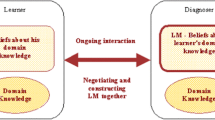Abstract
In this paper we will describe, outline and exemplify the functionalities and architecture of a User and Learner Modeling System called TAGUS (within the project “Theory and Applications for General User/Learner-modeling Systems”).
TAGUS was developed with two main goals: (1) to develop a framework to represent models of users and learners where the meta-cognitive activities of learners were taken into account; and (2) to try to capture in a system some general mechanisms and techniques for user and learner modeling in the form of services.
The basic idea of TAGUS is to achieve a kind of workbench where some techniques and approaches for user and learner modeling are implemented and applied. TAGUS provides a set of services, to be used by people testing methods or by applications using user models. These services, provided to external agents, embed some mechanisms for maintaining models of the users and learners. Thus, TAGUS plays a role of a user and learner modeling server.
To achieve this goal, we first identified some basic mechanisms in user and learner modeling, and based on them we established a general modeling cycle. This cycle involves two main stages: the acquisition and the maintenance of the model. The different strategies and techniques are specified in separate modules or knowledge sources in TAGUS, which uses them to execute parts of that cycle. The architecture of TAGUS is composed of: a User or Learner Model (ULM); a set of maintenance functions; an acquisition engine; a reason maintenance system; a meta-reasoner and two interfaces.
At the same time, TAGUS provides a language for defining the models of the users and learners, which can be used with different techniques, in order to test the models and simulate them in the system. This language is used not only to represent the models, but also as a way of establishing the communication between TAGUS and its environment.
TAGUS was built incrementally around a set of core functions for the manipulation of the User or Learner Model (ULM). Other layers of this set were built where the last layer corresponds to the services TAGUS supplies.
Similar content being viewed by others
References
Brajnik, G. and C. Tasso: 1994, ‘A Shell for developing non-monotonic user modeling systems’.International journal of Human-Computer Studies 40(1), 31–62.
Bredeweg, B. and J. Breuker: 1993, ‘Device Models for Model-based Diagnosis of Student Behavior’. In: P. Brna, S. Ohlsson, and H. Pain (eds.):Artificial Intelligence in Education, pp. 441–448.
Brusilovsky, P.: 1993, ‘Student as User: Towards an Adaptive Interface for Intelligent Learning Environment’. In: Paul Brna, Stellan Ohlsson, and Helen Pain (eds.):Artificial Intelligence in Education.
Darpa, E. I. G.: 1992. ‘Specification of the KQML agent communication language’. Technical report, The DARPA Knowledge Sharing Initiative. Available at http://www.cs.umte.edu/kqml/papers/kqmlspec.ps.
Finin, T.: 1989, ‘GUMS — A General User Modeling Shell’. In: A. Kobsa and W. Wahlster (eds.):User Models in Dialogue Systems.
Finin, T., D. McKay, R. Fritzson, and R. McEntire: 1994, ‘KQML: An Information and Knowledge Exchange Protocol’. In: Kazuhiro Fuchi and Toshio Yokoi (eds.):Knowledge Building and Knowledge Sharing.
Genesereth, M. and S. Ketchpel: 1994, ‘Software Agents’.Communications of ACM 37(7), 48–53.
Hoppe, H. U.: 1993, ‘Deductive Error Diagnosis and Inductive Error Generalization for Intelligent Tutoring Systems’.Journal of Artificial Intelligence in Education 5(1), 27–49.
Huang, X., G. McCalla, J. Greer, and E. Neufeld: 1991, ‘Revising Deductive Knowledge and Stereotypical Knowledge in a Student Model’.User Modeling and User-Adapted Interaction 1(1), 87–115.
Ikeda, M. and R. Mizoguchi: 1994, ‘FITS: A Framework for ITS — A Computational Model of Tutoring’.Journal of Artificial Intelligence in Education 5(3), 319–348.
Kass, R.: 1989, ‘Student Modeling in Intelligent Tutoring Systems — Implications for User Modeling’. In: A. Kobsa and W. Wahlster (eds.):User Models in Dialogue Systems, pp. 386–410.
Kay, J.: 1990, ‘um: a user modelling toolkit’. In:Proceedings of the Second Intl. User Modelling Workshop, Honolulu p. 1–11.
Kay, J.: 1991, ‘Generalized user modeling shells: a taxonomy’. In: J. Kay and A. Quilici (eds.):Proceedings of the IJCAI Workshop on Agent Modeling for Intelligent Interaction, pp. 169–185.
Kay, J.: 1993, ‘Reusable tools for user modelling’.Artificial Intelligence Review 7, 241–251.
Kay, J.: 1995, “The urn toolkit for reusable, long term user models’.User Modeling and User-Adapted Interaction. (This issue).
Kobsa, A. and W. Pohl: 1995, ‘The User Modeling Shell System BGP-MS’.User Modeling and User-Adapted Interaction 4(1), 59–106.
Kok, A.: 1990. ’User Modeling for Data Retrieval Applications’. Ph.D. thesis, University of Amsterdam, The Netherlands.
Kono, Y, M. Ikeda, and R. Mizoguchi: 1994, “THEMIS: A Nonmonotonic Inductive Student Modeling System’.Journal of Artificial Intelligence in Education 5(3), 371–413.
Paiva, A. and H. Coelho: 1992, ‘Stereotypes based User Models Representation and Reasoning’. In:ERCIM-Workshop on Knowledge Representation.
Paiva, A. and J. Self: 1994, ‘A Learner Model Reason Maintenance System’. In: Tony Conn (ed.):ECAI'94 — Proceedings of the European Conference on Artificial Intelligence.
Paiva, A., J. Self, and R. Hartley: 1994, ‘On the Dynamics of Learner Models’. In: Tony Cohn (ed.):ECAI'94 — Proceedings of the European Conference on Artificial Intelligence.
Paiva, A., J. Self, and R. Hartley: 1995, ‘Externalising Learner Models’. In: J. Greer (ed.):AI-ED'95 World Conference on Artificial Intelligence in Education 1995.
Self, J.: 1994, ‘Formal Approaches for Student Modeling’. In: J. Greer and G. McCalla (eds.):Student Modeling: the key to individualized knowledge-based instruction, pp. 295–352.
Self, J.: 1995, ‘Dormorbile: a vehicle for metacognition’. In: T. Chan and J. Self (eds.):Intelligent Computer Technologies in Education (to appear).
Takeuchi, A. and S. Otsuki: 1992, ‘EXPITS: an experimental Environment on ITS’. In: C. Frasson, G. Gauthier and G. McCalla (eds.):Intelligent Tutoring Systems, pp. 124–131.
Warren, K., B. Goodman, and S. Maciorowski: 1993, ‘A Software Architecture for Intelligent Tutoring Systems’. In: P. Brna, S. Ohlsson, and H. Pain (eds.):Artificial Intelligence in Education, 1993.
Author information
Authors and Affiliations
Rights and permissions
About this article
Cite this article
Paiva, A., Self, J. TAGUS — A user and learner modeling workbench. User Model User-Adap Inter 4, 197–226 (1994). https://doi.org/10.1007/BF01100244
Received:
Accepted:
Issue Date:
DOI: https://doi.org/10.1007/BF01100244




